2007 Q&A ArchiveUkulele History
& Vintage Ukuleles:
Questions, Answers, and
Information
2007 Archive
Click Here to
Ask a Question or Send Information
Date: December 31, 2007
Question:
Martin Style O? I'm trying to find information about this uke that I recently acquired. Can you tell me what year it was made? The front pegboard has a design where the decal should be. Any idea what the design means?
Answer:
You have a very nice Martin ukulele there. However, it is not an "Martin 0". It is a Martin Style 2k soprano. The style 0 was a plain mahogany model, the style 2k is a fancier model made from Hawaiian koa wood. The 2k is a much more valuable ukulele.
Martin made the 2k model like yours from the late teens through the early 1930s, when they started using a decal on the headstock. Based on the tuning pegs on your ukulele I would date it to around the first half of the 1920s. You also have the top-of-the-line plush-lined hardshell case.
The design on the headstock was probably added by a former owner on the ukulele, I don't think it would detract substantially from the instrument's value.
|  | 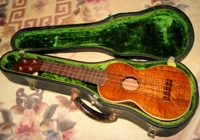
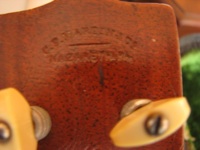
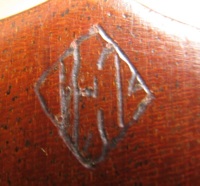
|

Date: December 31, 2007
Question:
I recently acquired this little soprano. The guy I got it from had no idea where it came from or who might have made it. He got it at a garage sale. I really like it and have no intention of selling or getting rid of it. I honestly don't care what it's monetary value might be. I would just like to know a little about it's history and heritage. It's very nicely made and is very solid. I'm pretty sure it's mahogany. I can find nothing that might be an identifying mark of any kind. I'm afraid that's all I know about it. Any more info you could provide me with would be greatly appreciated. In any case I intend to enjoy playing it for a long time to come. Mahalo nui loa.
Answer:
That is an interesting ukulele you have there. Unfortunately, I'm afraid I can't tell you a whole lot about it. It looks like a pre-WWII instrument and I too would guess that it is made from mahogany. It looks professionally made, but it doesn't remind me of any specific manufacturer that I have seen. It has some characteristics of a Hawaiian-made ukulele (including the bridge and the arched back), but most of the Hawaiian-made ukuleles were made of koa wood. The headstock shape is unusual and is unlike any of the well-know manufacturers in Hawaii or on the mainland. The headstock is similar to the shape used by Oscar Schmidt, but not quite the same - and none of the other characteristics look like Schmidt. So, all-in-all I guess I can't tell you much - just that it looks like a nicely made and unusual ukulele.
|  | 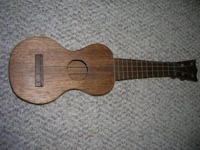
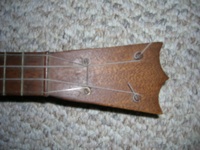
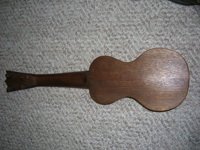
|

Date: December 31, 2007
Question:
Can you tell me anything about this concert ukulele? The headstock has the Regal shape. It looks like one of their better quality ukes - ribbon mahogany and nicely bound.
Answer:
I agree that your ukulele is a Regal. The bridge is identical to the bridge Regal used on a number of concert-sized instruments. The bindings and headstock shape both look like Regal also, though your ukulele is definitely one of the better ones they made. That looks like some very nice mahogany - by looking through the soundhole it looks like the back is made from that same curly wood.
Your ukulele some pretty nice tuning pegs too. They might not be original though - there are marks on the back of the headstock that suggest that larger diameter pegs were once on this uke. Anyway, if I had to guess I would say it is made in the late 1920s or 1930s. I hope it plays as nice as it looks.
|  | 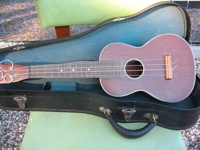
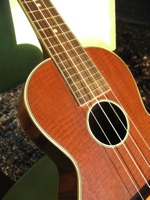
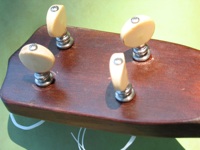
|

Date: December 31, 2007
Question:
Dear esteemed sirs, I recently purchased a soprano duke kahanamoku ukulele, and would like any info you have on where, when, and what year it possibly is. Please note there is no 'aloha' sticker on the headstock. Thank you for your help.
Answer:
I have seen lots of Duke Kahanamoku ukuleles over the years, but I have to say yours is one of the nicest looking ones I have seen. As far as I know all Duke Kahanamoku model ukuleles were manufactured in Asia. I have seen some marked "Japan" and other probably more recent ones marked "Taiwan". I know there are some people who claim some "Duke Kahanamoku" model ukuleles were made in Hawaii, but I have never seen one that was Hawaiian made.
I really have no way of saying for sure where or when your ukulele was made. If I had to guess from the looks of yours, I would guess that it was made in Japan in the 1950s or 1960s. It looks like a very well-made version in either koa wood or fancy mahogany.
|  | 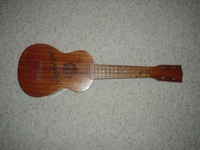
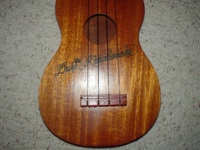
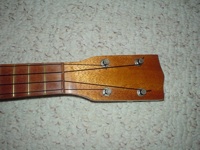
|

Date: December 31, 2007
Question:
I recently purchased this banjo ukulele and was told that it is a "Washington Brand" model from the 1930's. Can you tell me any more about it?
Answer:
You have a nice quality banjo ukulele, probably made in the 1920s or early 1930s. I can't say for sure who the manufacturer is. The "Washington" brand was a name used by J. W. Jenkins Music Co. of Kansas City, MO. so it is quite possible that your banjo ukulele was sold by Jenkins. However, Jenkins sold instruments made by many different manufacturers. The star inlay on the headstock is something often seen on instruments made by Vega, a well-regarded Boston-based manufacturer of banjos and other instruments. However, there are other instruments with the star inlay that were not made by Vega. An expert on Vega instruments could probably tell you whether your banjo ukulele appears to have been made by Vega. One way or another, it looks like a good quality instrument. Many banjo ukuleles were very cheaply made and not much more than toys. Yours, however, looks like a well-built musical instrument and it appears to be in great shape too.
Update (6/29/2008): Thanks to Dave S., who wrote in to point out that this banjo-ukulele looks a great deal like other banjo ukuleles produced by the Slingerland Company. After reviewing many Slingerland banjo-ukuleles, we agree with Dave's assessment - it is most likely that this banjo ukulele is a product of the Slingerland Company. Check out Dave's site for more info on banjo ukuleles: www.banjoukes.com
|  | 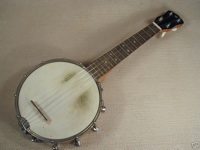
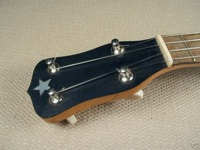
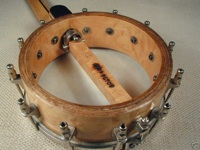
|

Date: December 31, 2007
Question:
Hello. I believe this Ukulele was manufactured in the 1920s. Can we have further details? Thanks
Answer:
You have a Martin Style 0 ukulele. It is a soprano-sized ukulele with a mahogany body. Martin introduced the style 0 in 1922, and used the stamp on the back of the headstock until the early 1930s, so you ukulele was made somewhere in that time period. The tuning pegs look to be original, and assuming that they are, your ukulele was probably made during or after the late 1920s when Martin switched from wooden friction pegs to the patent tuners like yours. Although this ukulele was the bottom of the Martin line, they are high quality instruments and are sought after by players for their sound.
|  | 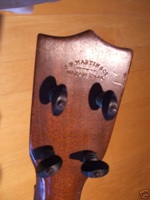
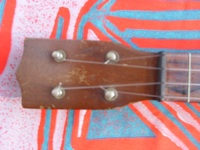
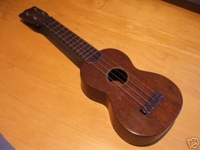
|

Date: December 31, 2007
Question:
I own a old martin ukulele with ivory pegs and a few bite marks on the head. It was my great grandmas.
Answer:
You have a Mahogany Martin Style 0 soprano ukulele. From the looks of it, I would estimate that it was made in the later 1940s or 1950s. I know that you said that the tuning pegs are ivory, but from the pictures they appear to be the standard tuning pegs that Martin used during this time period. The standard tuners were good quality tuners that were made by the Kluson company. They had plastic knobs in an off-white color similar to ivory. The style 0 was the bottom of the Martin line, but is still a quality instrument that is sought after by players. Yours appears to be in great condition except for the couple of marks on the headstock.
|  | 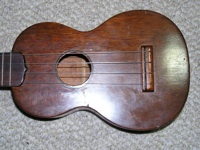
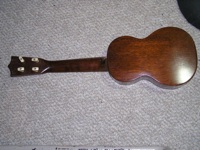
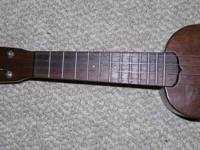
|

Date: December 31, 2007
Question:
Mom bought this uke in either 1949 or 1950. I remember her playing it at New Years circa 1950. Could you tell me some more info on it? Thank you so much.
Answer:
You have a nice looking mahogany ukulele made by the Harmony Company of Chicago Illinois. Harmony was owned by Sears but they manufactured instruments that were sold by many retailers. They made a huge number of ukuleles over the years (as well as guitars, mandolins, banjos, and other instruments). Their instruments were generally inexpensive but often played well and sounded good for the price. You happen to have one of the high end models - made with solid mahogany. Their less expensive models were probably mostly birch. Their less expensive models from this time period also generally had a plastic fretboard - yours has the more desirable wood fretboard. Your ukulele's size makes it a soprano - also known as standard size. It looks like it is in great shape.
|  | 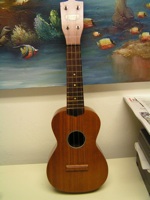
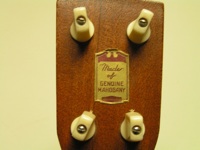
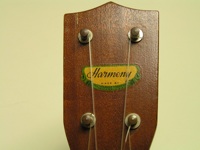
|
 
Date: December 31, 2007
Question:
Hi, My grandfather gave a Ukulele years back, the label inside reads 'Made expressly for Frank J. Hart Southern California Music Company by M. Nunes & Sons Inventor of the Ukulele...'. Is this Ukulele rare? Any info would be great, thanks.
Answer:
Your ukulele was made by the company founded by Manuel Nunes. Nunes immigrated with his family to Hawaii from Madeira in 1879. He was one of the three original ukulele makers in Hawaii. He changed the name of his company to M. Nunes and Sons in 1910 and he stayed in business until about 1917.
Nunes made instruments almost exclusively of Hawaiian koa wood. He made a number of different models of ukulele. The plainest has no fancy trim around the body or soundhole. Fancier models have wooden inlays around the soundhole and/or the top edge of the body. Based on the label, your ukulele was almost certainly made between 1910 and 1917.
M. Nunes & Sons ukuleles are not extremely rare - but they are very desirable instruments because of Nunes' place in ukulele history. Your ukulele is a relatively fancy model with the inlaid "rope" binding around the top of the body. The paper label inside your ukulele is from the Southern California Music Company - a large musical instrument distributor that sold M. Nunes ukuleles in the teens.
|  | 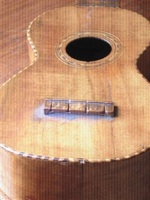
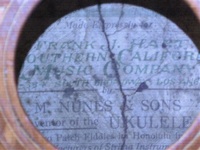
|

Date: December 31, 2007
Question:
Do you have any info on a Martin ukulele most likely over 65 years old? It was my dad's and is in fine condition but each store I bring it to cannot give me a good idea of it's uniqueness. It has a small ivory plate on the top (above the keys) that says "the student". I don't have the dim's of this instrument and can get along with mfg. numbers if that is helpful. So if you could let me know if you have an idea about this old Martin ukulele or want more info. please let me know. Thanks for your help.
Answer:
Thanks for the photos of your Martin ukulele. You have a 1920s era Martin Style 3 ukulele. It has a mahogany body and neck and an ebony fingerboard, and is the standard size model known as a soprano. The stamp on the back of headstock and inside the body read "C. F. Martin & Co., Nazareth, Pa." Martin made very high quality instruments and the style 3 is one of their high-end models. Until the very fancy style 5K was introduced in 1922 the Style 3 was their top-of-the-line model. Martin made Style 3 ukuleles as far back as 1916, but the specific appointments on your ukulele suggest a manufacture date in the early 1920s.
The plaque on the front of the headstock is very unusual. It was almost certainly added by the retailer that sold the ukulele - I don't feel it is not something that Martin would have included. I have never seen this particular plaque before, but I have occasionally seen others that are similar on different ukulele models. More often, a store would add a plaque with the name of their store on it. It is strange that they were selling this model under the name "The Student" - as I said it was one of Martin's highest-priced models. You'd expect a "The Student" plaque on a Style 0 or a Style 1 (Martin's two least expensive models), but on a Style 3 I'd expect "The Professional" or at least "The Teacher" or something.
Your ukulele is valuable. Martins are highly sought after by players and collectors alike for their outstanding sound. Many consider them the very best ukuleles made, and all other brands are compared to the fine Martin standard. The style 3 is rarer than the less expensive models, and is more sought after by players. This is also partly due to the extended 17 fret fretboard that allows playing notes and chords that aren;t possible on the 12 fret neck of the lower-priced models. The plaque on your ukulele, although unusual, probably does little to add to its value - it actually might keep some people away because it makes the ukulele less "original".
|  | 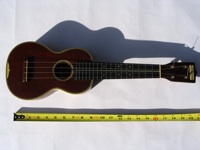
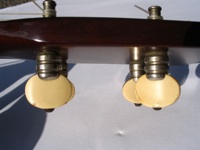
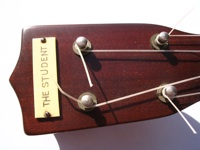
|

Date: December 30, 2007
Question:
Trying to find out an approximate age of this ukulele I got at an estate sale but can't find info on it. It is 20 3/4 inches long, has a pineapple on the head as seen and says from territory of hawaii which I think dates to at least the 50's or older. It has the wooden I guess those 4 things at the head are called tuners. It is in excellent shape no scratches or dings at all. Here are the pictures and the picture of the case.
Answer:
Your Kamaka ukulele is a standard shaped soprano. It appears to be made from monkeypod wood. In this time period, this body shape is probably not quite as common as a pineapple body. The monkeypod is not as desirable as koa wood. It looks to me like Kamaka's typical of the 1940s period. Kamaka was the premier ukulele manufacturer in Hawaii during most of this time period - so they built quite a few ukuleles. Therefore, your ukulele is not especially rare, but it is still a popular model for both players and collectors. Your ukulele appears to be in excellent condition - almost as though it has never been played. Even the case appears to be in nice shape.
|  | 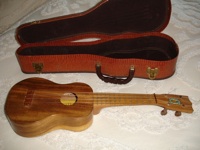
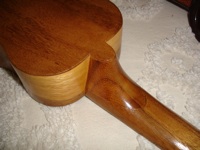
|
 
Date: September 22nd, 2007
Question:
Hi ! i've bought a vintage ukulele on ebay and i wonder who and when it has been probably made. It seems to be koa wood and the seller thinks it's from the 20's or 30's. Many thanks !
Answer:
I'm quite sure that your ukulele is a model that was manufactured by the Harmony Co. of Chicago Illinois. It was probably made in the 1920s, or possibly even in the later teens. Harmony was owned by Sears, and many of the instruments they made were sold through Sears under the Supertone brand name. Your ukulele model looks a lot like a Supertone model that was sold in the Sears catalogs for many years. The unusual fretboard extension and the headstock shape are rather distinctive features see on the Harmony ukuleles. A similar model sold in the 1923 Sears catalog for $4.95 - their second most expensive ukulele at the time. Harmony sold similar ukuleles in both koa and mahogany, but from your photos I would guess that your ukulele is koa.
|  | 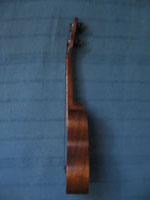
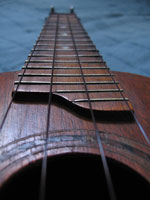
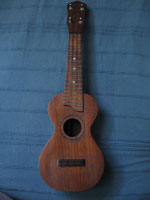
|

Date: September 22, 2007
Question:
Hello. I bought this ukulele at a garage sale this summer. Just wondered if you could tell me when it was made ,judging by the decal on the neck. It has a plastic fret board, but actually has a decent sound! The The picture on the ukulele is in nice shape. Any info would be great! Thank-you.
Answer:
I guess you already know this much - you have a stenciled ukulele manufactured by The Harmony Co. of Chicago Illinois. Harmony was owned by Sears, but manufactured instruments that were sold by many different retailers. These painted Harmonies were made in a number of colors and were made for many years, approximately from the late 1930s to around 1970. The plastic fingerboard models were introduced (I believe) after World War II - certainly by the mid 1950s. In a 1957 catalog, Harmony describes the "ingenious 'Accurately Molded' polystyrene plastic fingerboard for moderately priced wood instruments" and goes on to say that it offers "fretting that is perfection itself". The decal aging and the two-color stencil on your ukulele make me think that it is from the 1950s.This model was an inexpensive model, and they are not particularly rare. Still they can be decent sounding instruments - they were made with solid woods. It sold for $8.95 in 1957 - near the bottom of Harmony's inexpensive ukulele lineup.
|  | 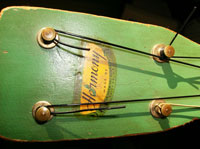
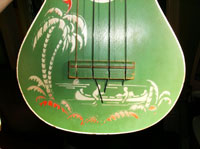
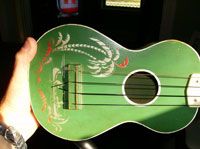
|

Date: September 13th, 2007
Question:
I recently purchased a Guild Ukulele at a garage sale with a serial number #U16 made in Hoboken NJ. I am curious if it is rare? It is in excellent condition. What is the history behind this? Thanks
Answer:
Your Guild ukulele is pretty rare - I have only seen a few in many years of following the vintage ukulele market. Your ukulele must be a baritone - a large model of ukulele typically about 30" long. I'm pretty sure that it is the only size ukulele that Guild made. The Guild factory was in Hoboken from about 1956 to 1966, but they first made baritone ukuleles in the early 1960s. They made a model U11 (later changed to B11) and a U21 - I haven't found any reference to a U16 model. They continued to make baritone ukuleles until the mid 1970s, but since yours was made in Hoboken it dates to the early to mid 1960s. Guild made some very nice instruments. Although I have never played one of their ukuleles, I'd guess that they are good quality instruments.
|

Date: September 13, 2007
Question:
Dear Ukulele Hall of Fame, Who, When and where was the Peter Pan Uke manufactured? Many thanks.
Answer:
Your instrument is what is known as a banjo ukulele. It is tuned and played like a standard ukulele.
The "Peter Pan" ukulele was a brand name sold by the Progressive Musical Instrument Corporation (P'mico). P'mico was an instrument distributor, but not a manufacturer. They were based in New York City and sold instruments that were made by a number of different companies. The "Peter Pan" name was registered by P'mico in 1926, but was first used as early as 1924. It was used on many different models of ukulele and a number of different banjo ukuleles. It was generally used on inexpensive instruments, sometimes with painted designs on the front of the body or on the skin. They did also use the name on some better quality instruments, generally labeling them "Peter Pan DeLuxe".
Banjo ukuleles like yours were inexpensive instruments that were very popular in the 1920s and into the early 1930s. Most of these were made by one of the big instrument manufacturers in Chicago. The shape of the headstock on your ukulele makes me believe that it was made by The Harmony Co. Harmony was a big instrument manufacturer owned by Sears, but they sold instruments to many different distributers. P'mico probably applied the headstock decal and painted the three little dots on the fingerboard.
|  | 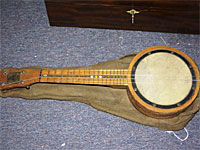
|

Date: September 10th, 2007
Question:
Hi Guys! I have a Camp Uke that has been passed down to me from My grandmother and I am hoping you can help me more clearly identify it. To me it is priceless because of the sentimental value. It has several initials and dates carved lightly on it's back, including my grandfathers dated 1927, before they were married. My grandfather was born in 1905 so that places him at 22 years of age at the time. My grandmother must have been around the same age, I'm not sure of her exact d.o.b.. She signed it herself in 1925 along with some of her friends. Some other unique features this instrument has, is a 7" round body, oval sound hole, and a very dark finish which makes it hard to identify the wood. On the tunning board it has "Camp Uke" carved or stamped into it. On the bridge it has ( PAT.APLD FOR ). This uke doesn't look like a very expensive one because of it's simple design. It plays nicely. I have had it since I was a teenager so it preceded my guitar days. Every once in a while I get it down from a display of older stringed instruments that my wife and I have collected and hung in our music room. So if you can help me with this let me know. I'm really excited to find out more about it. Thanks.
Answer:
Thanks for writing in. "Camp Uke" was a brand name used by Lyon and Healy, one of the big distributors of musical instruments based in Chicago. The "Camp Uke" name was used on a line of ukuleles that included models that ranged from a low to mid-priced. They are pretty durable little instruments and can sound pretty good. There were a number of different models made through the 1920s, all with round bodies. Some models had no soundhole at all, while more often they featured a circular or oval soundhole (like yours). Some have a flat wooden back, others have a turned wooden back. Some fancier models featured a gold-leaf decal below the bridge.
The "Camp Uke" name was registered by Lyon and Healy in 1923, but was first used in 1921. Lyon and Healy used unusual woods on some of their ukuleles. The Camp Ukes were made from Nyssa wood. The 1925 Lyon and Healy catalog features three models of Camp Uke all "made of two-ply, laminated Nyssa wood". It goes on to explain that "Laminated means that the wood is two layers, the grains cross-wise, carefully glued together. The one layer reinforces the other. Nyssa wood is strong, not easily cracked, and possesses wonderful vibrating qualities." The catalog states that the Camp Ukes are "exclusive Lyon and Healy products, made in the famous Washburn factory". The three models sold for $6.00, $7.50 and $10.00.
I am glad that you consider it priceless and I think it is really great that it has your grandparents names carved into its body. Enjoy it!
|

Date: August 23, 2007
Question:
I bought this little soprano ukulele on Ebay about 10 days ago. It seems to be a very well made ukulele. I would like to know very much who or what company made it. Thanks!
Answer: (updated 8/24/07)
From your photos I would say that you ukulele appears to have been made by the Oscar Schmidt company. The main Oscar Schmidt factory was located in Jersey City, NJ. They were a manufacturer of many different types of musical instruments including banjos, mandolins, guitars, ukuleles, and autoharps. They sold instruments under their own name, as well as under brand names such as Stella and Sovereign. Most of the instruments they manufactured were inexpensive to medium-grade instruments. The Oscar Schmidt company existed until the late 1930s when they were purchased by the Harmony company. In 1979 the name was purchased by Washburn. For the last few years, Washburn has been distributing a new line of ukuleles under the Oscar Schmidt brand name.
Your ukulele was probably manufactured in the 1920s or 1930s. It looks to have had a bit of work done to it. The body appears to have been refinished and the inlay on the headstock does not appear to be original. The neck block is not the same as on other Schmidt ukes I have seen, perhaps work was done on this area also. On the few of these that I have seen, the typical bridge for this type of ukulele has a similar profile to yours, but has a metal saddle. However, I have seen at least one other Schmidt ukulele with an all-wood bridge very similar to yours, so I don't really have any reason to believe that your bridge is not original. The shape of the ukulele, the fretboard extension, and the inlay work all are typical of Oscar Schmidt. In particular, the stripe down the center of the back is seen on this type of Oscar Schmidt ukulele and was not commonly used by other manufacturers. Your ukulele likely originally had a paper label inside. The label on these ukuleles featured an island scene with a seated hula girl playing an ukulele and the words "Hawaiian Ukulele" written in large letters across the top - clearly visible through the soundhole. In much smaller letters across the bottom of the label (at an angle making it much more difficult to read) were the words "Manufactered by Oscar Schmidt, Inc. Jersey City, NJ."
|  | 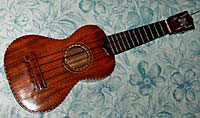
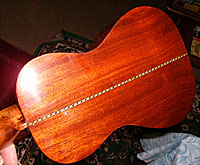
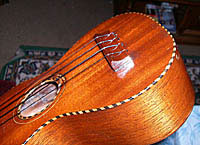
|

Date: August 20, 2007
Question:
I have a ukulele labled The Serenador, B & J, New York, It was purchased before 1950, can you provide any information on this for me or guide me in the right direction where to look?
Answer:
B & J stands for Buegeliesen and Jacobson. B&J was an instrument distributor based in New York City. The company formed in 1901 and was in business until 1975. They did not manufacture their own instruments. Instead, they sold instruments made by an assortment of different companies. Their instruments were sold under a number of brand names, including Serenader, Mele, and SS Stewart.
Instruments sold under the serenader name include guitars, tenor guitars, ukuleles, banjo-ukuleles, and later, baritone ukuleles. The Serenader name was first used on Ukuleles in 1926. The trademark was registered in 1927 and renewed in 1947, so it was used for quite a long period of time. It was used on instruments that were supplied to B&J by a number of different companies over the years, including the Chicago manufacturers Harmony, Stromberg-Voisinet (later Kay), and quite possibly Regal.
In the 1950s (and probably later) B&J was still selling Serenader brand instruments - at least some of these were instruments imported from Japan. If you can send a photo or two of your ukulele, I can tell you more about it. I could give you the approximate age, and possibly even the specific manufacturer. |

Date: August 4, 2007
Question:
Hello Uke hall of fame, I recently picked up this old uke at an antique shop. It appears to be amazingly built. I was wondering what is the rarity of this instrument if any. I know its an Elias Howe Co uke that was built by the Cole brothers. It is a tenor according to measurements. Thanks.
Answer:
Thanks for sending in the first question to our new Question and Answer
area! It is a great question about a very nice looking ukulele.
Elias Howe, Co. was a musical instruments retailer in Boston, MA. The company had been founded by Elias Howe in 1840 and was incorporated in 1898 by his two sons. This is not the same Elias Howe who invented the sewing machine - although they were apparently distant relatives. Howe sold some instruments under the "Superbo" brand name, most notably banjos that were made by W. A. Cole. The Cole company was sold in 1922, but the Cole name may still have been used on instruments after that date.
It is interesting to me that your ukulele is marked "Cole" - I don't think I have seen that marked on an ukulele before. I have seen a few Howe "Superbo" ukuleles in the past, but they were all sopranos - yours is the first tenor I have seen. The sopranos I have seen have always been high quality instruments, similar in many ways to Martin ukuleles of the same period. Your tenor appears to be a very well made instrument in great condition. The fact that it is tenor-sized suggests to me it is probably from 1925 or later, as there weren't really many true tenor-sized ukuleles made before that. If it was made after 1925, it was actually made after the Cole company had been sold so I can't say for sure who the actual manufacturer was.
The inlays on the fingerboard and around the soundhole are both very nice and unusual. The bridge on your ukulele is more typical of the type used on tiples. The tiple is an instrument with 10 steel strings in four courses, tuned like an ukulele. The tiple is also about the same body size as a tenor ukulele. Sorry I can't give you a lot more information about your ukulele, but it appears to be a very high quality instrument and quite unusual.
Here are a couple of sites with more information about Elias Howe: Gregg Miner's excellent site MinerMusic and another detailed page about Howe , and one with more information on W. A. Cole from the excellent mugwumps website.
|  | 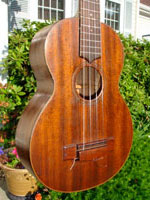
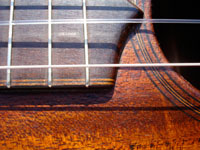
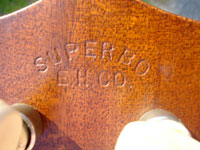
|
|



















